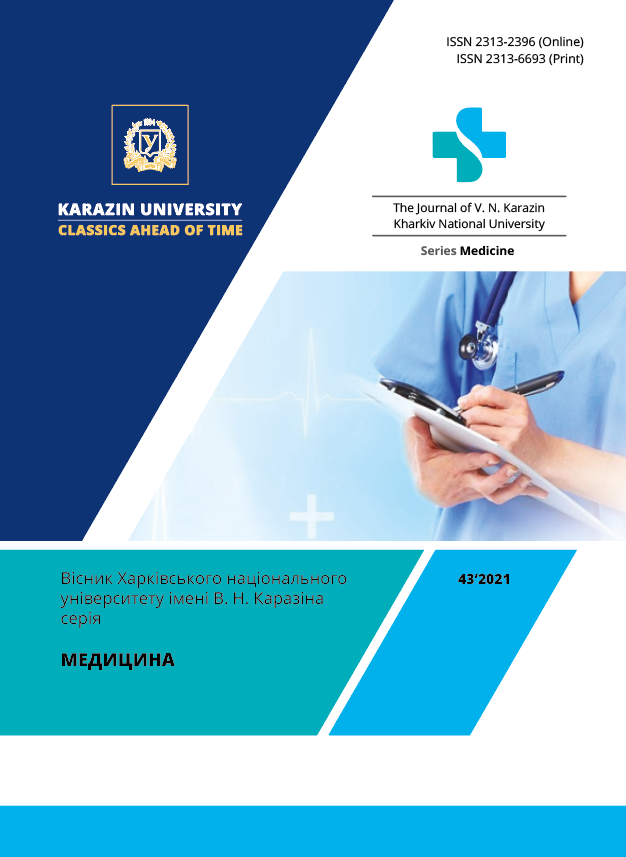A rare type of postoperative abdominal herniation
Abstract
Resume. Postoperative abdominal hernia is considered the most common complication in abdominal surgery. Aim. To acquaint medical practitioners with the clinical case of diagnosis and treatment of impaired postoperative contraperture true abdominal hernia on the background of a closed abdominal injury. Materials and methods. We present a clinical case of our own observation of the clinical course, diagnosis and treatment of impaired postoperative contraperture true abdominal hernia with necrosis of the loop of the small intestine and necrosis of the large omentum, acute strangulation small intestinal obstruction, general serous-fibrinous peritonitis, adhesive peritoneal disease of the 2nd degree at patient with closed abdominal trauma. Results. The patient with a closed abdominal injury, the results of the examination and treatment of which are given in the article, in the anamnesis - cholecystoectomy 39 years ago. The preliminary diagnosis: closed abdominal trauma, peritonitis. Intraoperatively, a case of true postoperative abdominal hernia of rare localization - contraperture hernia. It was taking into account the patient's complaints, medical history, results of physical examination, the results of laboratory and instrumental methods of research available at the time of examination. The clinical interest is not only the rarity of the birth of this pathology, but also the history of the disease, diagnostic search, clinical picture and treatment tactic. Conclusions. In this case, the patient was probably a hernia carrier for many years, and the injury only provoked the infringement. The patient sought medical help late, as result of which the picture of peritonitis was obvious. This made it possible to quickly decide on the need for surgical treatment. Otherwise, the likelihood of a tactical error is not excluded. We believe this case is interesting because one should always remember about the possible surgical pathology against the background of a closed abdominal trauma.
Downloads
References
Kroese LF, Sneiders D, Kleinrensink GJ. et al. Comparing different modalities for the diagnosis of incisional hernia: a systematic review. Hernia. 2018; 22: 229–242. Doi: https://doi.org/10.1007/s10029-017-1725-5
Piotrovich SM, Vasilchuk OV, Andriiets VS. Basic principles of surgical treatment of recurrence of postoperative abdominal hernia after alloplasty. Hospital Surgery. Journal named by L.Ya. Kovalchuk [Internet]. 2021 Apr. 30; (1): 72–6. Doi: https://doi.org/10.11603/2414-4533.2021.1.11959 [in Ukraine]
Harikrishnan CP, Vakayil HJ. Prospective and retrospective study of incisional hernias in a tertiary care hospital. Int Surg J. 2017; 4: 2670–76. Doi: http://dx.doi.org/10.18203/2349-2902.isj20173185
Henriksen NA, Jensen KK, Jorgensen LN. The Biology of Hernia Formation. In: Hope W, Cobb W, Adrales G, editor. Textbook of Hernia. Springer, Cham. Doi: https://doi.org/10.1007/978-3-319-43045-4_1
Egiev VN, Lyadov KV, Voskresenskii PK. Atlas operativnoi khirurgii gryzh. M: Medpraktika-M; 2003. 230 s. [in Russian]
Bender E, Sell H. Small bowel obstruction after laparoscopic cholecystectomy as a result of a Maydl's herniation of the small bowel through a trocar site. Surgery. 1996 Apr; 119 (4): 480. Doi: https://doi.org/10.1016/s0039-6060(96)80152-8. PMID: 8644017
Howard R, Thompson M, Fan Z, Englesbe M, Dimick JB, Telem DA. Costs Associated With Modifiable Risk Factors in Ventral and Incisional Hernia Repair. JAMA Netw Open. 2019; 2 (11): e1916330. Doi: https://doi.org/10.1001/jamanetworkopen.2019.16330
Köckerling F. Recurrent Incisional Hernia Repair-An Overview. Front Surg. 2019 May 14; 6: 26. Doi: https://doi.org/10.3389/fsurg.2019.00026. PMID: 31139632; PMCID: PMC6527885.
Liang MK, Holihan JL, Itani K, Alawadi ZM, Gonzalez JR, Askenasy EP, Ballecer C. Ventral Hernia Management: Expert Consensus Guided by Systematic Review. Ann Surg. 2017 Jan; 265 (1): 80–89. Doi: https://doi.org/10.1097/SLA.0000000000001701. PMID: 28009730.
Slonetskyi BI, Tutchenko MI, Verbytskyi IV, Kotsiubenko VO. Current trends in diagnostic and treatment tactics in patients with strangulated ventral hernias. Zaporozhye medical journal. 2021; 23 (4), 583–589. Doi: https://doi.org/10.14739/2310-1210.2021.4.232565. [in Ukraine]
Mnari W, Hmida B, Maatouk M, Zrig A, Golli M. Strangulated obturator hernia: a case report with literature review. Pan Afr Med J. 2019 Mar 26; 32: 144. Doi: https://doi.org/10.11604/pamj.2019.32.144.14846. PMID: 31303916; PMCID: PMC6607289
Bakker WJ, Aufenacker TJ, Boschman JS, Burgmans JPJ. Lightweight mesh is recommended in open inguinal (Lichtenstein) hernia repair: A systematic review and meta-analysis. Surgery. 2020 Mar; 167 (3): 581–589. Doi: https://doi.org/10.1016/j.surg.2019.08.021. Epub 2019 Oct 28. PMID: 31672519
Saito T, Fukami Y, Uchino T, Kurahashi S, Matsumura T, Osawa T, Arikawa T, et al. Preliminary results of robotic inguinal hernia repair following its introduction in a single-center trial. Ann Gastroenterol Surg. 2020 Jun 4; 4 (4): 441–447. Doi: https://doi.org/10.1002/ags3.12341. PMID: 32724888; PMCID: PMC7382428
The Journal of V. N. Karazin Kharkiv National University, series Medicine has following copyright terms:
- Authors retain copyright and grant the journal right of first publication with the work simultaneously licensed under a Creative Commons Attribution License that allows others to share the work with an acknowledgement of the work’s authorship and initial publication in this journal.
- Authors are able to enter into separate, additional contractual arrangements for the non-exclusive distribution of the journal’s published version of the work, with an acknowledgement of its initial publication in this journal.
- Authors are permitted and encouraged to post their work online prior to and during the submission process, as it can lead to productive exchanges, as well as earlier and greater citation of published work.




